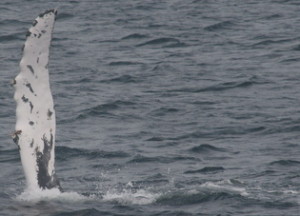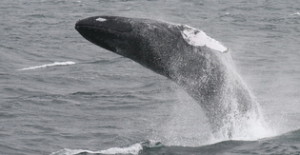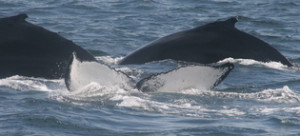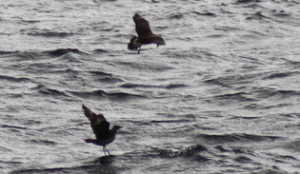Dolphin Fleet Naturalist Notebook – 27 September to 3 October
This week (10/24 – 10/31) is the last week of whale watching on the Dolphin Fleet this season. There are still humpbacks, fin whales, and Minkes, as well as seals, Mola molas, and great bird sightings. The weather looks great for the last week of October, so try to get out and see some whales before hunkering down for the winter!
September 27th was gray and foggy. With our limited visibility, our morning trip was challenging, although we were able to catch a glimpse of a Mola mola, or ocean sunfish. Our luck improved during the afternoon when we found 7 humpbacks over southern Stellwagen Bank. Many of them were smaller animals, and our naturalist supposed that they must be juveniles. In general, we can identify individual humpback whales based on the unique patterns on the undersides of their tails. Every Dolphin Fleet whale watch boat carries a catalog containing photos of thousands of humpback whale flukes. We see so many whales throughout the season that not all of the individuals make it into the catalog right away! For now, these whales will remain anonymous, but over the winter we spend countless hours trying to figure out the identities of our unknown humpbacks.
On September 29 the skies has cleared and we steamed back to Stellwagen Bank. With increased visibility, we were able to find several more humpbacks, one of which was breaching! This one was another small, unnamed juvie with a lot of energy. This little whale breached for over 20 minutes!
As the trip went on, we began to see more familiar flukes, both young and old. In a group of six whales, we were able to identify the 2009 calf of a whale named Mars. Mars has been around for over 20 years, and is now a grandmother, but she is still giving birth herself! We also saw one of our favorite humpback whales, Salt. Salt had a calf this year herself, but today that young whale was nowhere in sight. Like humans, there is some variability as to when humpback whale calves venture off on their own. At this time of the year, Salt’s calf is about nine months old, meaning that he or she is at an age where leaving mom is a distinct possibility.
Even more humpbacks had were seen the afternoon of September 30th, and we began our trip with a humpback named Wingspan who was lobtailing. Wingspan was named for the bird in flight like marking on the underside of its fluke. This whale was seen repeatedly smacking its tail on the surface of the water near the site of the old Peaked Hill Buoy. 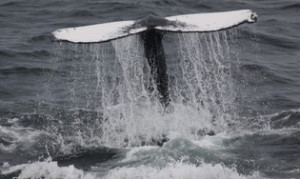
Throughout the trip, humpback whale social groups were splitting and merging until a group of six, including Circuit, Circuit’s 2010 calf, Tapioca and Mars’ 2009 calf. Trench, Salt, and Vulture’s 2008 calf were also in the mix, and it looked like they were searching for food deep in the water column.
High winds on October 1st prevented our boats from leaving the harbor, but by October 2nd we were ready to brave the seas. The choppy water and high winds prevented us from going past the protected arm of Race Point, but fortunately, there were whales close to shore. We were treated to a quick peak at a Mola mola as we passed by the Herring Cove Beach bath house. After that, some of our favorite humpbacks made appearances. Ventisca, a whale famous for the white markings on her fluke and back, surfaced and fluked while traveling by herself. Elephant, as well as an unknown humpback dove as a pair.
The winds stayed strong into October 3rd, but the whales were near the Peaked Hill buoy site, and we were able to get excellent looks at 8-9 humpback whales. While for most people, the whales are the most captivating wildlife of the trip, a growing subgroup of Dolphin Fleet passengers are out here for another reasons — for the excellent birdwatching. Fall is a great time to see migrating birds, unusual gulls, and of course, the jaegers. Jaegers display a behavior known as kleptoparasitism in which they chase and harass birds of other species until they drop their food, which the jaegers then snatch up. Today, our naturalist John snapped some great shots of jaegers as they flew right up the starboard side of the Portuguese Princess II!






